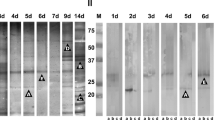Abstract
Three recombinant antigens viz. arginine kinase, cathepsin L-1 and TES-26 of Toxocara canis were expressed in Escherichia coli and evaluated for their potential in the detection of T. canis larval infection in human in immunoglobulin G-enzyme linked immunosorbent assay (IgG-ELISA). Results of the IgG-ELISA with the above recombinant antigens were confirmed with commercially available IgG detection kit for T. canis infection used as a standard test. All three recombinant antigens were 100% sensitive in the detection of positive cases (n = 6) of T. canis infection in human and were screened for their cross-reactivity in human patients with history of Toxoplasma gondii, Plasmodium vivax, Entamoeba histolytica, hydatid and hookworm infections. The recombinant TES-26 antigen showed higher specificity and cross-reacted with T. gondii infection sera only. However, arginine kinase and cathepsin L-1 recombinant antigens showed cross-reactions with sera of patients infected with T. gondii, P. vivax and E. histolytica but not with the patient sera infected with hydatid and hookworm. These results show that recombinant TES-26 is a potential diagnostic candidate antigen for human toxocarosis caused by migrating T. canis larvae.
Similar content being viewed by others
References
Bagde V., Jacob S. S., Samanta S., Sahu S, Sudhakar N.R., Chamuah J.K., et al. 2013. Cloning and expression of Toxocara canis arginine kinase recombinant protein for serodetection of toxocarosis in dogs. Journal of Veterinary Parsitology, 27, 70–73
Elefant G.R., Shimizu S.H, Jacob C.M., Sanchez M.C., Ferreira A.W. 2011. Potential immunological markers for diagnosis and therapeutic assessment of toxocariasis. Journal of the Institute of Tropical Medicine of São Paulo, 53, 61–65. DOI: 10.1590/S0036-46652011000200001
Ellington W.R. 2001. Evolution and physiological roles of phosphagen systems. Annal Review of Physiology, 63, 289–325. DOI: 10.1146/annurev.physiol.63.1.289
Fong M., Lau Y. L., Init I., Jamaiah I, Anuar A.K., Rahmah N. 2003. Recombinant expression of Toxocara canis excretory-secretory antigen TES-120 in Escherichia coli. The Southeast Asian Journal of Tropical Medicine and Public Health, 34, 723–726. DOI: 10.4269/ajtmh.15-0190
Fong M., Lau Y. L. 2004. Recombinant expression of the larval excretory-secretory antigen TES-120 of Toxocara canis in the methylotropic yeast Pichia pastoris. Parasitology Research, 92, 173–176. DOI: 10.1007/s00436-003-1020-5
Gawor J., Borecka A., Marczyńska M., Dobosz S., Żarnowska-Prymek H. 2014. Risk of human toxocarosis in Poland due to Toxocara infection of dogs and cats. Acta Parasitologica, 60, 99–104. DOI: 10.1515/ap-2015-0012
Iddawela R.D., Rajapakse R.P.V.J., Perera N.A.N.D., Agatsuma T. 2007. Characterization of a Toxocara canis species specific excretory secretory antigen (TcES-57) and development of a double sandwich ELISA for diagnosis of visceral larva migrans. Korean Journal of Parasitology, 45, 19–26. DOI: 10.3347/kjp.2007.45.1.19
Jin Y., Shen C., Huh S., Sohn W.M., Choi M.H., Hong S.T. 2013. Serodiagnosis of toxocariasis by ELISA using crude antigen of Toxocara canis larvae. Korean Journal of Parasitology, 51, 433–439. DOI: 10.3347/kjp.2013.51.4.433
Kocięcki J., Kocięcka W., Dmitriew A. 2016. Toxocarosis of the organ of sight-the complex pathological and diagnostic problem. Acta Parasitologica, 61, 1–9. DOI: 10.1515/ap-2016-0001
Loukas A., Selzer P.M., Maizels R.M. 1998. Characterization of Tccpl-1, a cathepsin L-like cysteine protease from Toxocara canis infective larvae. Molecular and Biochemical Parasitology, 92, 275–289. https://doi.org/10.1016/S0166-6851(97)00245-4
Marchioro A.A., Colli C.M., Ferreira É.C., Tiyo R., Mattia S., de Souza W.F., Falavigna-Guilherme A.L. 2013. Identification of public areas with potential toxocariasis transmission risk using geographical information systems. Acta Parasitologica, 58, 328–333. DOI: 10.2478/s11686-013-0142-x
Mohamad S., Norhaida A., Noordin R. 2009. Development and evaluation of a sensitive and specific assay for diagnosis of human toxocariasis by use of three recombinant antigens (TES-26, TES-30USM, and TES-120). Journal of Clinical Microbiology, 47, 1712–1717. DOI: 10.1128/JCM.00001-09
Noordin R., Smith H.V., Mohamad S., Maizels R.M., Fong M.Y. 2005. Comparison of IgG-ELISA and IgG4-ELISA for Toxocara serodiagnosis. Acta Tropica, 93, 57–62. DOI: https://doi.org/10.1016/j.actatropica.2004.09.009
Norhaida A., Suharni M., Liza Sharmini A.T, Tuda J., Rahmah N. 2008. RTES-30USM: Cloning via assembly PCR, expression and evaluation of usefulness in the detection of toxocariasis. Annals of Tropical Medicine and Parasitology, 102, 151–160. DOI: 10.1179/136485908X252250
Olave A.M., Mesa J.A., Botero J.H., Patino E.B., Garcia G.M., Alzate J.F. 2016. Production and evaluation of the recombinant antigen TES-30 of Toxocara canis for the immunodiagnosis of toxocariasis. Biomedica, 36, 39–51. DOI: 10.7705/biomedica.v36i1.2617
Wickramasinghe S., Uda K., Nagataki M., Yatawaraa L., Rajapakse R.P.V.J., Watanabe Y., et al. 2007. Toxocara canis: molecular cloning, characterization, expression and comparison of the kinetics of cDNA-derived arginine kinase. Experimental Parasitology, 117, 124–132. DOI: 10.1016/j.exppara.2007.03.015
Wickramasingh S., Yatawara L., Nagataki M., Takamoto M., Watanabe Y., Rajapakse R.P.J., Uda K., Suzuki T., Agatsuma T. 2008. Development of a highly sensitive IgG-ELISA based on recombinant arginine kinase of Toxocara canis for serodiagnosis of visceral larva migrans in the murine model. Parasitology Research, 103, 853–858. DOI: 10.1007/s00436-008-1067-4
Zahabiun F., Sadjjadi S.M., Yunus M.H., Rahumatullah A., Moghaddam M.H.F., Saidin S., Noordin R. 2015. Production of Toxocara cati TES-120 recombinant antigen and comparison with its T. canis homolog for serodiagnosis of toxocariasis. American Journal of Tropical Medicine and Hygiene, 93, 319–325. DOI: 10.4269/ajtmh.15-0190
Author information
Authors and Affiliations
Corresponding author
Rights and permissions
About this article
Cite this article
Varghese, A., Raina, O.K., Chandra, D. et al. Sero-detection of Toxocara canis infection in human with T.canis recombinant arginine kinase, cathepsin L-1 and TES-26 antigens. Acta Parasit. 62, 775–778 (2017). https://doi.org/10.1515/ap-2017-0093
Received:
Revised:
Accepted:
Published:
Issue Date:
DOI: https://doi.org/10.1515/ap-2017-0093




